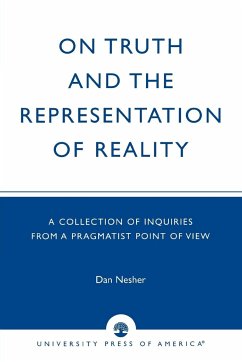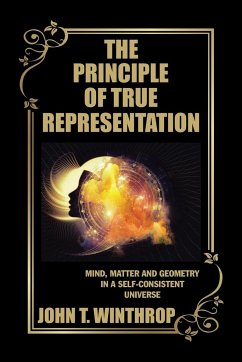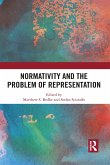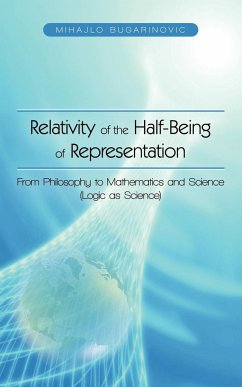Dan Nesher
On Truth and the Representation of Reality
A Collection of Inquiries from a Pragmatist Point of View
Dan Nesher
On Truth and the Representation of Reality
A Collection of Inquiries from a Pragmatist Point of View
- Broschiertes Buch
- Merkliste
- Auf die Merkliste
- Bewerten Bewerten
- Teilen
- Produkt teilen
- Produkterinnerung
- Produkterinnerung
In On Truth and the Representation of Reality, Dan Nesher develops a new theory of truth in the framework of pragmatist theory of representation. Using the pragmatist theory of perception for the basis of his epistemological explanation of our confrontation with external Reality and how it's represented, Nesher shows that in our perceptual operations we quasi-prove the truth of our perceptual judgments.
Andere Kunden interessierten sich auch für
![The Principle of True Representation The Principle of True Representation]() John T. WinthropThe Principle of True Representation24,99 €
John T. WinthropThe Principle of True Representation24,99 €![Normativity and the Problem of Representation Normativity and the Problem of Representation]() Normativity and the Problem of Representation59,99 €
Normativity and the Problem of Representation59,99 €![Relativity of the Half-Being of Representation - From Philosophy to Mathematics and Science (Logic as Science) Relativity of the Half-Being of Representation - From Philosophy to Mathematics and Science (Logic as Science)]() Mihajlo BugarinovicRelativity of the Half-Being of Representation - From Philosophy to Mathematics and Science (Logic as Science)9,49 €
Mihajlo BugarinovicRelativity of the Half-Being of Representation - From Philosophy to Mathematics and Science (Logic as Science)9,49 €![The World as Will and Representation (The World as Will and Idea), Volume II of III The World as Will and Representation (The World as Will and Idea), Volume II of III]() Arthur SchopenhauerThe World as Will and Representation (The World as Will and Idea), Volume II of III13,99 €
Arthur SchopenhauerThe World as Will and Representation (The World as Will and Idea), Volume II of III13,99 €![The World as Will and Representation (The World as Will and Idea), Volume III of III The World as Will and Representation (The World as Will and Idea), Volume III of III]() Arthur SchopenhauerThe World as Will and Representation (The World as Will and Idea), Volume III of III13,99 €
Arthur SchopenhauerThe World as Will and Representation (The World as Will and Idea), Volume III of III13,99 €![Descartes and the Puzzle of Sensory Representation Descartes and the Puzzle of Sensory Representation]() Raffaella De RosaDescartes and the Puzzle of Sensory Representation36,99 €
Raffaella De RosaDescartes and the Puzzle of Sensory Representation36,99 €![The Metaphysics of Representation The Metaphysics of Representation]() J Robert G WilliamsThe Metaphysics of Representation31,99 €
J Robert G WilliamsThe Metaphysics of Representation31,99 €-
-
-
In On Truth and the Representation of Reality, Dan Nesher develops a new theory of truth in the framework of pragmatist theory of representation. Using the pragmatist theory of perception for the basis of his epistemological explanation of our confrontation with external Reality and how it's represented, Nesher shows that in our perceptual operations we quasi-prove the truth of our perceptual judgments.
Produktdetails
- Produktdetails
- Verlag: Globe Pequot Publishing Group Inc/Bloomsbury
- Seitenzahl: 492
- Erscheinungstermin: 4. November 2002
- Englisch
- Abmessung: 229mm x 152mm x 29mm
- Gewicht: 792g
- ISBN-13: 9780761824541
- ISBN-10: 0761824545
- Artikelnr.: 31207616
- Herstellerkennzeichnung
- Libri GmbH
- Europaallee 1
- 36244 Bad Hersfeld
- gpsr@libri.de
- Verlag: Globe Pequot Publishing Group Inc/Bloomsbury
- Seitenzahl: 492
- Erscheinungstermin: 4. November 2002
- Englisch
- Abmessung: 229mm x 152mm x 29mm
- Gewicht: 792g
- ISBN-13: 9780761824541
- ISBN-10: 0761824545
- Artikelnr.: 31207616
- Herstellerkennzeichnung
- Libri GmbH
- Europaallee 1
- 36244 Bad Hersfeld
- gpsr@libri.de
Dan Nesher teaches Philosophy at the University of Haifa, Israel, and was a Visiting Scholar at several universities including Harvard University, Indiana University at Bloomington, and University of Pittsburgh, Pennsylvania. He has written articles on Philosophy of Language, Theory of Knowledge and Theories of Meaning and Truth
Chapter 1 Foreword Chapter 2 Introduction Chapter 3 Spinoza's Theory of
Truth Chapter 4 Peircean Realism: Truth as Meaning of Cognitive Signs
Representing External Reality Chapter 5 Pragmatist Realism: The Third
Philosophical Perspective as the "Intermediate Point" between "Metaphysical
Realism" and "Internal Realism" Chapter 6 "Which Side Spinoza Would Have
Taken [between Einstein and Bohr] if He had Lived to See the [Scientific]
Development of Our Days" (Bohr, 1949:237): An Analysis of Human
Representation of Physical Reality Chapter 7 The Pragmatist Conception of
Truth with a "Bold" Solution to the Liar Paradox Chapter 8 In Spite of
Davidson's Arguments for "The Folly of Trying to Define Truth," Truth Can
be Defined Chapter 9 We Know What Our Propositions Represent When We Prove
Their Truth: Response to Gettier Chapter 10 Putnam on Truth: Can We Know
Reality with a Big "R" with Proved Truths with a Small "t?" Chapter 11
Pragmatic Theory of Truth: Are Frege's and Ramsey's Equation "p is true =
p" and Tarski's Equivalence "X is true if, and only if, p" True? Chapter 12
The Pragmatist Conceptions of "Fact," "True Proposition," "Truth
Conditions," and "True to the Facts:" Our Knowledge of External Reality
Chapter 13 Bibliography Chapter 14 Index
Truth Chapter 4 Peircean Realism: Truth as Meaning of Cognitive Signs
Representing External Reality Chapter 5 Pragmatist Realism: The Third
Philosophical Perspective as the "Intermediate Point" between "Metaphysical
Realism" and "Internal Realism" Chapter 6 "Which Side Spinoza Would Have
Taken [between Einstein and Bohr] if He had Lived to See the [Scientific]
Development of Our Days" (Bohr, 1949:237): An Analysis of Human
Representation of Physical Reality Chapter 7 The Pragmatist Conception of
Truth with a "Bold" Solution to the Liar Paradox Chapter 8 In Spite of
Davidson's Arguments for "The Folly of Trying to Define Truth," Truth Can
be Defined Chapter 9 We Know What Our Propositions Represent When We Prove
Their Truth: Response to Gettier Chapter 10 Putnam on Truth: Can We Know
Reality with a Big "R" with Proved Truths with a Small "t?" Chapter 11
Pragmatic Theory of Truth: Are Frege's and Ramsey's Equation "p is true =
p" and Tarski's Equivalence "X is true if, and only if, p" True? Chapter 12
The Pragmatist Conceptions of "Fact," "True Proposition," "Truth
Conditions," and "True to the Facts:" Our Knowledge of External Reality
Chapter 13 Bibliography Chapter 14 Index
Chapter 1 Foreword Chapter 2 Introduction Chapter 3 Spinoza's Theory of
Truth Chapter 4 Peircean Realism: Truth as Meaning of Cognitive Signs
Representing External Reality Chapter 5 Pragmatist Realism: The Third
Philosophical Perspective as the "Intermediate Point" between "Metaphysical
Realism" and "Internal Realism" Chapter 6 "Which Side Spinoza Would Have
Taken [between Einstein and Bohr] if He had Lived to See the [Scientific]
Development of Our Days" (Bohr, 1949:237): An Analysis of Human
Representation of Physical Reality Chapter 7 The Pragmatist Conception of
Truth with a "Bold" Solution to the Liar Paradox Chapter 8 In Spite of
Davidson's Arguments for "The Folly of Trying to Define Truth," Truth Can
be Defined Chapter 9 We Know What Our Propositions Represent When We Prove
Their Truth: Response to Gettier Chapter 10 Putnam on Truth: Can We Know
Reality with a Big "R" with Proved Truths with a Small "t?" Chapter 11
Pragmatic Theory of Truth: Are Frege's and Ramsey's Equation "p is true =
p" and Tarski's Equivalence "X is true if, and only if, p" True? Chapter 12
The Pragmatist Conceptions of "Fact," "True Proposition," "Truth
Conditions," and "True to the Facts:" Our Knowledge of External Reality
Chapter 13 Bibliography Chapter 14 Index
Truth Chapter 4 Peircean Realism: Truth as Meaning of Cognitive Signs
Representing External Reality Chapter 5 Pragmatist Realism: The Third
Philosophical Perspective as the "Intermediate Point" between "Metaphysical
Realism" and "Internal Realism" Chapter 6 "Which Side Spinoza Would Have
Taken [between Einstein and Bohr] if He had Lived to See the [Scientific]
Development of Our Days" (Bohr, 1949:237): An Analysis of Human
Representation of Physical Reality Chapter 7 The Pragmatist Conception of
Truth with a "Bold" Solution to the Liar Paradox Chapter 8 In Spite of
Davidson's Arguments for "The Folly of Trying to Define Truth," Truth Can
be Defined Chapter 9 We Know What Our Propositions Represent When We Prove
Their Truth: Response to Gettier Chapter 10 Putnam on Truth: Can We Know
Reality with a Big "R" with Proved Truths with a Small "t?" Chapter 11
Pragmatic Theory of Truth: Are Frege's and Ramsey's Equation "p is true =
p" and Tarski's Equivalence "X is true if, and only if, p" True? Chapter 12
The Pragmatist Conceptions of "Fact," "True Proposition," "Truth
Conditions," and "True to the Facts:" Our Knowledge of External Reality
Chapter 13 Bibliography Chapter 14 Index









